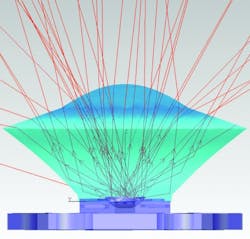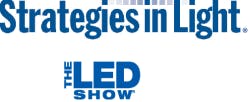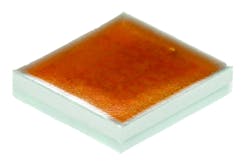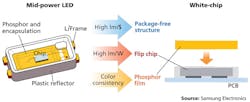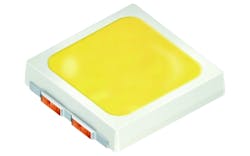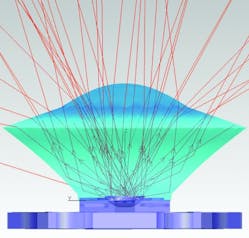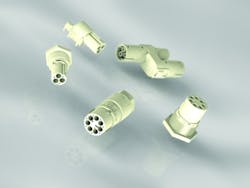The co-located Strategies in Light and The LED Show conferences and exhibitions will provide attendees with an immersive educational and networking experience covering the range from the latest LED components to advanced SSL luminaire designs, writes MAURY WRIGHT.
As always, the plenary sessions will be among the most anticipated events of SIL week. Last year, the packaged LED market was projected on a significant growth path with 2013 revenue reported at $14.4B (billion) and 2018 revenue projected at $25.9B. The 2015 update will surely be interesting. Without question, the number of LEDs being manufactured is escalating and the transition to LED sources in the general lighting market is happening faster than even SSL optimists had predicted. But the transition to mid-power LEDs in many lighting applications has resulted in lower component prices and indeed near commoditization on some classes of LED products.
Mid-power evolution
One of the important takeaways of 2015 SIL week will be an updated examination of the different types of LEDs being targeted at lighting applications. Just two years back, low-, mid-, and high-power designations neatly segmented the market. Today the boundaries are far from clear. As we have written previously, what look like plastic-packaged, mid-power devices regularly operate today in excess of 1W, previously the domain of high-power LEDs.
But the overlap between different types of LEDs goes much deeper than power level, although power level remains important. The mid-power devices of the past that were mostly packaged in plastic until recently were much less capable of operating at elevated temperature relative to high-power LEDs packaged in ceramic. Today, manufacturers are using composite materials, which still look like plastic but that enable longer component life at higher temperatures.
The electrical and optical feature set in mid-power LEDs has changed as well. Starting around SIL last year, we had seen manufacturers deliver mid-power LEDs with multiple emitters and relatively high forward voltages. Many companies offer products in the 9V range with some supplying devices up to the 36V range. Such high-voltage LEDs simplify the driver design because the drop from AC line voltage is lower in magnitude. Manufacturers are also adding features such as primary optics on some mid-power families.
At the other end of the spectrum, Cree is delivering ceramic-based high-power LEDs that look more like a traditional mid-power device. The surface-mount devices (SMDs) such as the new XLamp MHD family are designed to be assembled onto printed-circuit boards (PCBs) with automated pick-and-place equipment just like many mid-power LEDs. The MHD LEDs also have a near-flat light-emitting surface much like mid-power LEDs. But the LEDs can operate at a maximum of 19W, delivering 2500 lm — far greater than any product with a mid-power legacy.
Package-light LEDs
We also look forward to seeing how the LED manufacturing industry is progressing with chip-scale packages (CSPs). Philips Lumileds started the CSP trend at SIL two years back, introducing a high-power LED based on a thin-film, flip-chip architecture in which there is really no package. Essentially, the LED is simply a chip with contacts on the underside of the chip.
At SIL last year, Bangwon Oh, senior vice president of lighting marketing at Samsung Electronics, said a move to CSP was the only path to continue cost reduction in mid-power LEDs. At the time, he said the CSP architecture could meet the Samsung goal of delivering more than 2000 lm/$ (lumens per dollar) in an LED retrofit lamp.
Throughout the remainder of 2014, a number of other companies working in mid-power LEDs announced CSP architectures. The list includes LG Innotek, Toshiba with its gallium-nitride-on-silicon (GaN-on-Si) technology, and Luminus Devices. The value proposition is relatively simple. LED manufacturers can potentially apply phosphor at the wafer level with CSP architectures streamlining the back-end packaging process. And sources, including the US Department of Energy, have identified packaging as a continuing obstacle to lower-cost LEDs.
Still, the CSP technology is in the early stages of maturity. We haven’t seen such LEDs used widely at this point. Indeed, it’s unclear how many manufacturers are shipping such products in volume. And many lighting manufacturers may lack the manufacturing sophistication needed to utilize such LEDs. But we should get an update on the technology at SIL, and perhaps witness some lighting products that use the LEDs.
SIL workshops
Of course, the program for SIL week will feature numerous opportunities for attendees to learn about applying LED technology in addition to the update from the LED manufacturing perspective. The options include the immersive half- and full-day workshops. One that is sure to draw a crowd will focus on human-centric lighting (HCL). LEDs offer great potential to impact health and wellbeing through a tunable spectrum.
Some scientists have questioned whether we know enough about the non-visual receptors in humans that can trigger relaxation or alertness based on the spectral content of light. We covered some of the unknowns in a recent interview. The message was that the lighting industry needs to proceed carefully.
The speakers slated for the SIL workshop, however, believe the industry should move ahead now in developing HCL applications. Stan Walerczyk, principal at consulting firm Lighting Wizards, is one of the speakers. Walerczyk has experience in using tunable lighting capable of very high CCT levels in places such as classrooms to boost alertness. Walerczyk and another workshop speaker, John Hwang, CEO of Planled, also worked on a trial project with the Seattle Mariners Major League Baseball (MLB) team to install tunable lighting in the player locker room. The players are exposed to blue-rich light prior to a game to increase alertness. The lighting is tuned to a warm CCT after games to prepare the body for a restful night.
The group of presenters can also speak authoritatively on the subject of the blue light hazard — the potential that exposure to blue-rich LED light could damage the human retina. Walerczyk presented a recent webcast for LEDs Magazine on the topic. Most of the research that has documented the potential danger did not replicate light level or exposure time that is typical of indoor lighting.
Connected lighting
Throughout the workshops, Investor Forum, and full conference, one topic that will be at the forefront is connected lighting and networks. Indeed, some type of control is inherent in the aforementioned HCL application. But increasingly every light in a commercial building or every luminaire in a city-wide street light system will be networked (see our feature on the Danish Outdoor Lighting Lab coming soon with the February issue content). The connectivity can enable programmatic dimming for maximizing energy savings, automated maintenance operations, and operation as a signaling system in an emergency situation.
There will be a half-day SIL workshop dedicated to networked outdoor lighting control systems. The speakers include Dave Cavalcanti from Philips Research North America, Michael Poplawski from Pacific Northwest National Laboratory, and Mark Wilbur from GE Lighting.
Cisco keynote
The trend toward connected lighting systems is drawing new participants into the lighting industry. For example, data networking powerhouse Cisco has invested significant resources in adapting or extending its technology for SSL applications. The company is also very interested in the related Internet of Things (IoT) concept in which most everyday appliances are connected to the Internet. Indeed, the plenary track at SIL will feature a keynote speech by Tony Shakib, vice president of IoT vertical solutions at Cisco.
Shakib will discuss the benefits and vulnerabilities of network technology relative to lighting applications. He believes that order must come to the smart lighting industry because today there are mostly proprietary technologies being deployed, and from the broad perspective the smart-lighting arena is chaotic. Shakib will focus on the importance of carefully engineering networks for lighting, and he will provide an outlook on how SSL will fit into the Cisco vision of the IoT in the next five years.
SIL 2015 will also feature a full track dedicated to smart lighting. Another speaker from Cisco, Justin Buchanan, senior manager in product management, will present “How IoT is revolutionizing lighting.” Buchanan will dig deeper into network design and security, and will also cover the concept of using Power-over-Ethernet (PoE) technology to supply DC power and Ethernet connectivity to light fixtures.
Security will be a recurring topic in the smart lighting track. Paul Jauregui, vice president of marketing at Praetorian, will focus on security risks in his presentation. Philip Smallwood, SIL conference co-chair and director of LED and lighting research at Strategies Unlimited, recently interviewed Jauregui on the topic and the key points of the SIL talk.
Jauregui said Praetorian has built out a laboratory with connected lighting products including retrofit lamps from companies such as Philips, GE Lighting, TCP, and Belkin. About vulnerabilities, he said, “The most pressing issues we are finding start with security basics, including encryption, authentication, using clear-text protocols to transmit sensitive information such as passwords, default passwords are being used in customer environments, to name a few.”
The onus for security will be on both manufacturers of products and the customer that buys and installs the products, according to Jauregui. He said, “Consumers need to apply the same security hygiene to new Internet-connected devices, such as smart lighting systems, as they do to traditional computer and web-based services.”
The business of SSL
Beyond applying LED technology, SIL week will afford many opportunities to consider the business side of SSL. One of the most lauded talks at SIL 2014 came from Mark Rea, director of the Lighting Research Center (LRC) at Rensselaer Polytechnic Institute, focused on monetizing the benefits of SSL. For SIL 2015, Rea will chair a panel to further discuss the concept. The panel will include Jerry Duffy, general manager of global product management at GE Lighting; Lori Brock, director of research and innovation at Osram Sylvania; Karl Geisler, thermal engineer at Advanced Lighting Systems; and Peter Kuehnel, business leader of office, industry and healthcare at Philips Lighting.
Rea believes that the key to future prosperity for the SSL industry relies on the development and adherence to a new set of metrics that he calls benefit metrics. He acknowledges that characteristics such as efficacy and lumen rating are important. But Rea argues that we need metrics tied to benefits that lighting can deliver to humans.
He will assuredly again state the case for a new approach to color metrics with the message that the color rendering index (CRI) does not accurately characterize good color performance. According to Rea, the SSL industry must engineer good color rendering and, by doing so, increase profits and margins. But we need accurate metrics to measure the performance.
Rea is also going to steer the discussion to the HCL concept and how lighting affects the human circadian rhythm. But we have no metrics at present to characterize the benefits of light on our wellbeing. Development of such metrics would help create a path toward a healthy business for SSL manufacturers, according to Rea.
Exhibits
Moving to the exhibition associated with SIL and The LED Show, attendees will get the opportunity to examine a broad range of enabling technologies and lighting products. There will be connected lighting technologies on display along with the most efficient components on the market. Let’s consider some examples.
SIL will mark the first time that Cree has displayed its new LED portfolio that is based on the SC5 (silicon carbide 5) technology and manufacturing platform. The company announced SC5 back in November 2014, promising double the lumen output of prior LEDs that in turn could reduce SSL system cost by 40% through a simplification of the driver, thermal, mechanical, and optical elements of an LED-based lighting product.
Cree believes that a dominant focus for LED technology innovation is efficient light conversion — getting more light out of an LED even at higher operating temperatures. The company said with high-power LEDs that deliver better performance and a more effective way to achieve low-cost systems, manufacturers are no longer forced to use lower-reliability mid-power LEDs to achieve the lowest system cost.
Subsequent to the SC5 announcement and what Cree calls its Extreme High Power (XHP) family, the company announced the XHP50 and XHP70 LEDs that will be on display at SIL. The products can deliver more than 4000 lm from 5×5- or 7×7-mm packages. And in early 2015 the company announced the aforementioned MHD family of products in SMD packages. Cree also said that visitors can expect to see new milestones for LED arrays and the LMH2 module family at SIL.
Broad LED portfolios
While Cree continues to focus on high-power LEDs, other manufacturers including Osram Opto Semiconductors are spanning the mid-power to chip-on-board (COB) LED range. Osram will demonstrate that full range at SIL, including the mid-power Duris S 5 LEDs. The company has added LEDs in the family with CRI as high as 90 and with efficacy just above 100 lm/W for a 3000KCCT LED.
Osram’s LED portfolio also targets applications far beyond general illumination. For example, the company will exhibit the Ostar Stage LED at SIL for entertainment applications. The Soleriq family of COB LEDs will be on display. And the company will show the Oslon high-power LED family. Finally, Osram will demonstrate horticultural lighting technology for life science applications.
Also in the COB LED space, Flip Chip Opto will demonstrate its P Series of components. The LEDs use flip-chip components but are uniformly covered with phosphor. An LED with a 19-mm light-emitting surface (LES) can operate at 122W. The company said that it is pursuing maximum lumens per dollar with the family.
Enabling technologies
The enabling technologies for SSL product development that will be displayed at SIL go far beyond packaged LEDs. The mix will include design tools, interconnect technologies, and, of course, optical and thermal products.
In the tools area, Lambda Research will demonstrate the latest version 7.6 release of its TracePro optical simulation software. The company has added features such as a broader optical diffuser catalog, including options such as Bayer Makrolon material, while also streamlining the user interface. Moreover, the simulation accuracy has been enhanced. For example, the new package provides optical path-length data for each ray in a ray-tracing simulation.
In the area of interconnect, TE Connectivity will demonstrate the Nector M power-delivery system that consists of a modular, keyed wiring system with connectors that can only be plugged into the proper sockets. The Nector system is designed to distribute power in multi-luminaire projects in a manner that that simplifies the installation process and ensures reliability.
The company will also demonstrate poke-in wiring connectors designed for lighting products that are based on SMD technology. Lumawise holders for COB LEDs will be featured in the booth. And the company will demonstrate a new ANSI-C136.41-compliant dimming receptacle for outdoor SSL applications such as street lights.
ICs and MCUs
The broad semiconductor industry is also becoming more involved with the lighting sector with the transition to SSL, and IC-level products such as microcontrollers (MCUs) will be among the critical enabling technologies in the smart lighting products discussed previously. MCUs will be integrated with driver functionality or closely coupled with LED driver ICs.
One SIL exhibitor that will focus on smart lighting from the IC perspective is Microchip. The company will have two featured demonstrations. One will be IoT focused and rely on the PoE technology mentioned earlier to supply the constant current required by LEDs and the Ethernet connectivity for the MCUs integrated in luminaires for the demonstration. Microchip will utilize the Cisco EnergyWise protocol and provide examples of centralized- and distributed-control scenarios. In addition to enabling control of the example fixtures, the network allows the fixtures to report data such as operational status and power consumption.
Microchip will also team with Cree to showcase a new integrated driver and LED modular light engine. The reference design utilizes the Microchip CL800 Sequential Linear LED Driver and Cree XLamp XB-G LEDs to produce 1000 lm. The module can operate directly from an input as high as 230V, and the company said that it uses no inductors or high-voltage capacitors.
SSL luminaires
SIL week, and specifically The LED Show, will also feature a broad selection of general lighting products on display. Attendees can expect to see the latest in retrofit lamps, street lights, and indoor luminaires. One product that will stand out is the Horner Lighting high- or low-bay fixtures based on remote-phosphor technology. The products are designed to replace linear fluorescent or HID lighting while delivering better energy efficiency and improved light quality.
The products integrate light engines that look somewhat like fluorescent tubes, and indeed Horner uses the “tube” terminology, although that may not be technically accurate. The company said that the 160W two-tube fixture can replace 250–400W fixtures based on legacy lighting technologies.
Horner offers a number of features that can further benefit buildings that install the products. For example, 90-CRI options are available. Moreover, the company offers wireless controls and autonomous sensors. A choice of optical accessories can impact beam control, allowing lighting designers/specifiers to customize the products for the application at hand.
There will, of course, be far more to see during Strategies in Light and The LED Show. On Feb. 25, LEDs Magazine will recognize the winners of our inaugural Sapphire Awards with categories ranging from enabling technologies to lighting products. On Tuesday, the Investor Forum will reprise the Dragon’s Lair that was a hit at SIL 2014, pitting early-stage SSL companies against tough inquisitors from the financial community. And the networking receptions will afford all attendees the chance to connect with established colleagues and meet new ones.
